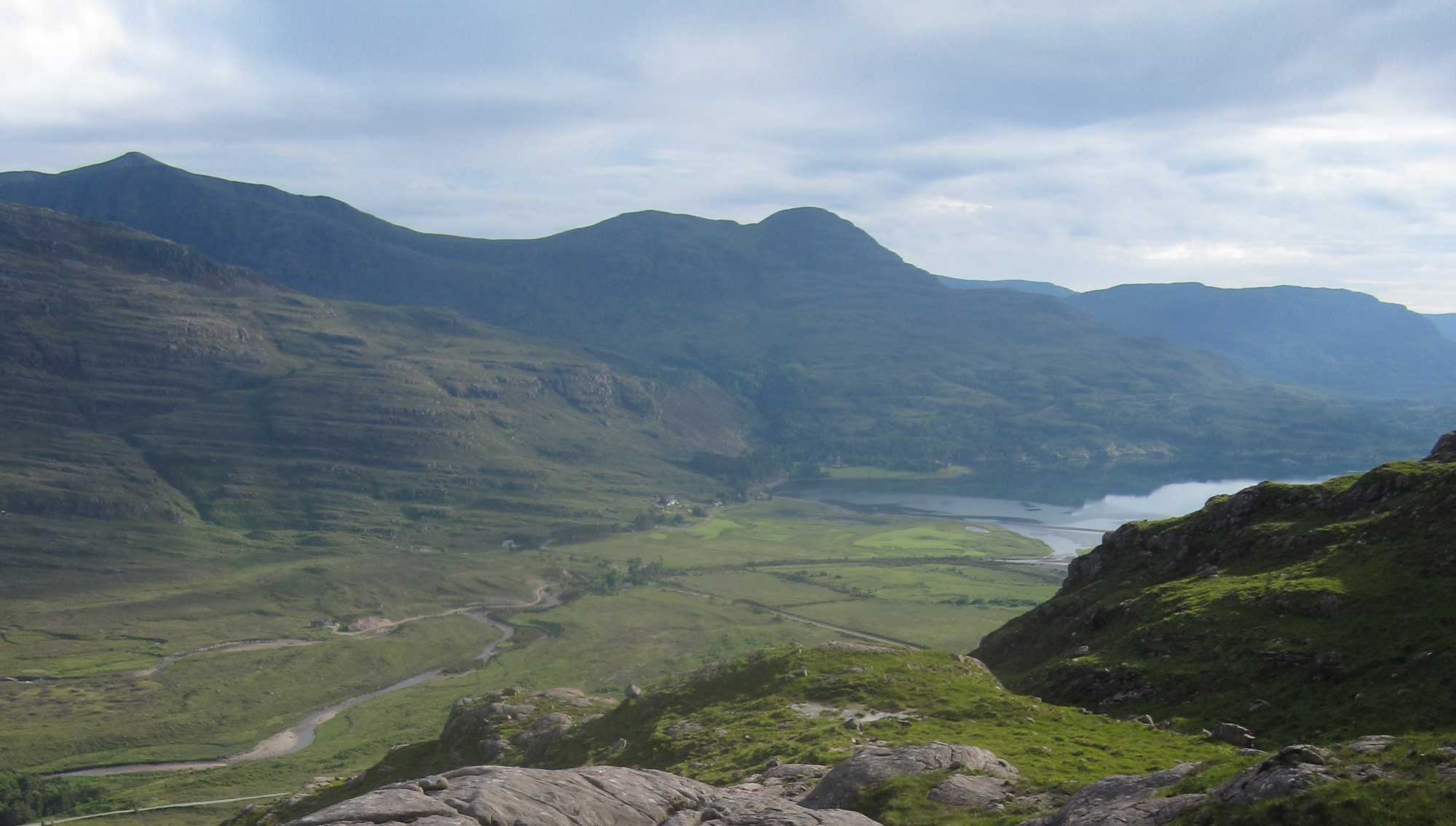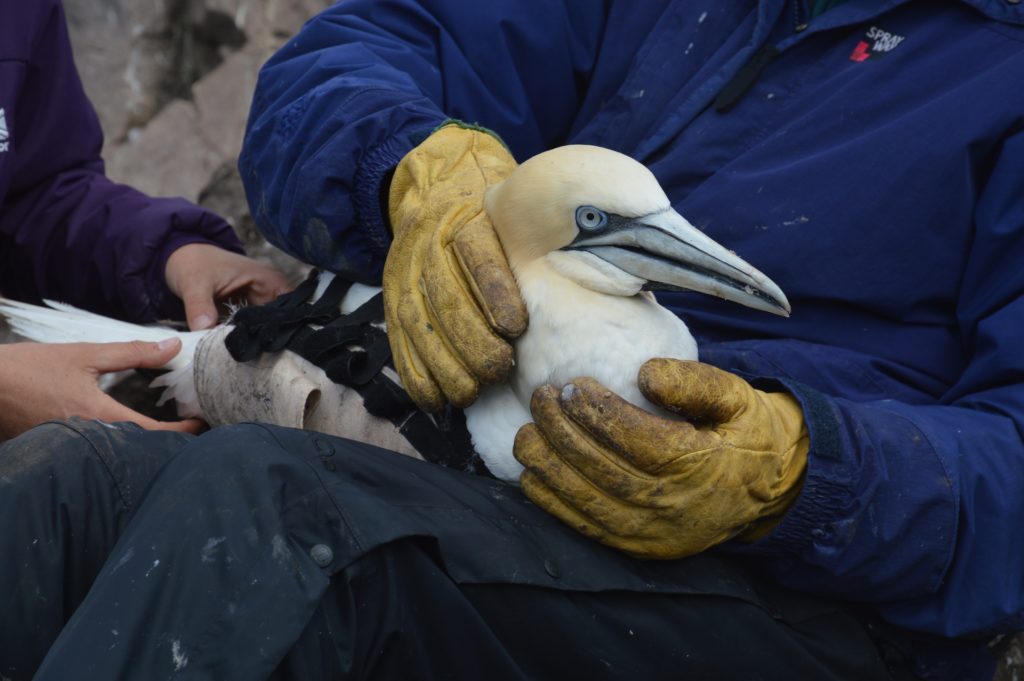
Tagging gannets on the Bass Rock.
I was lucky enough to visit the Bass Rock with Leeds University scientists to tag gannets. A short piece has already appeared in the Guardian Country Diary so I just wanted to add a few photos here and note my family connection to the island.
Just over a mile off the coast of Scotland, within sight of the Forth Railway Bridge, is a truly wild place. The Bass Rock, 100m at its highest point, is ringed with a halo of constantly honking seabirds. This is the largest colony of gannets on a single island on Earth, with up to 250,000 crowding into its three hectares in summer.
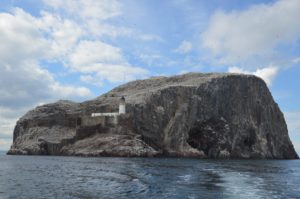
The Bass Rock.
Scientists from Leeds University are studying their foraging habits. Crucially, as more offshore wind farms are built, they want to know how high the birds fly before diving down to fish.
My cousin Robbie Dale took me out in early July with Jude Lane, Cat Horswill and Keith Hamer to watch the scientists carry out their research.
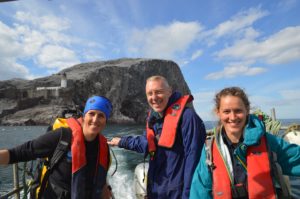
From left to right Jude Lane and Keith Hamer of Leeds University and Cat Horswill of the British Trust for Ornithology.
From the moment we step onto the rock we are surrounded by gannets. The young non-breeding birds are still growing in white feathers over their dark baby plumage and their stretched wings are striped black and white, like piano keys. Herring gulls scream through the constant honking of the young gannets. On the cliffs guillemots huddle like miniature penguins. Shags and cormorants nest below. Somewhere out of sight the resident pair of peregrine falcons await their next opportunity.
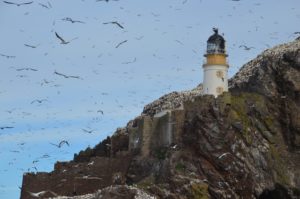
Gannets flying around the Bass Rock.
But the dominant species here is the gannet. As we climb onto the rock and further into their territory adult birds peck at our wellies.
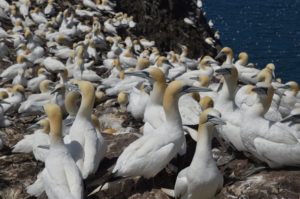
Gannets crowd onto the Bass Rock.
This is prime residential space and birds nest only pecking distance apart. Each pair will guard their nest constantly, taking turns to forage for fish and feed their young. Featherless babies, only a few days old, poke out from beneath their mothers and fathers, like little dinosaurs. Older fledglings look more like puppets with their black faces sticking out of balls of fluff, squeaking for more fish.
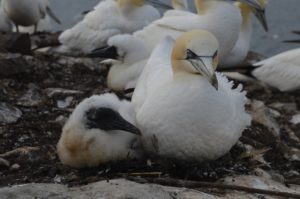
Adult gannet and young.
Once the young birds, or gugas, were caught and taken down to London to be sold as meat. Now they have created their own city. Any evidence of human habitation has been swamped in guano, or earth eroding under the sheer weight of the population. The lighthouse is boarded up. The ruins of the castle is overgrown in mallow and St Baldred’s Chapel is thick with nesting birds.
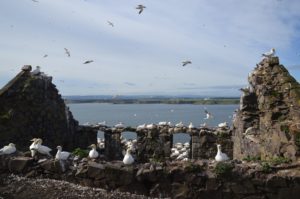
St Baldred’s Chapel on the Bass Rock is thick with nesting birds.
The adult northern gannets are gorgeous blondes, their yellow heads striking against the blue sea and white guano. Only their wing tips and tales are black. Their webbed feet are striped with mint green. Their grey eyes, on the front of the head to give binocular vision – like any predator, are lined in pale blue. Each colour is emphasisted by black lines, etched on their faces, like make up. The birds will live up to 35 years. The young grow fast, reaching 4.5kg in 12 weeks, so they are large enough to weather the autumn storms. Come September they tumble off the rock and learn to fly, so they can go to their feeding grounds off the north-west coast of Africa. The birds return to the Bass every summer, breeding at five years, and mostly mating for life. Depending on the feeding conditions they will fly as far as Norway during the breeding season to feed. The most productive areas are where estuaries like the Firth of Forth meet the sea, stirring up the seabed and nutrients for the ecosystem to feed on. Gannets are part of a mixed species feeding network, relying on dolphins, puffins and other species to dive down and stir up fish near the surface so they can in turn feed.
On the wing they are the most elegant birds, folding their wings and diving into the water at up to 90mph to catch their prey. Their original Latin name is sula bassanus, meaning arrow of the Bass.
But on land they are more like geese, hence their other name ‘solan geese’. The species are within the pelican biological order and you can see the likeness in the black pouch beneath the beak, used for storing regurgitated fish.
Birds stretch their necks skywards to signal they are about to leave the nest, known as sky pointing. Bonding behavior intertwining their beaks, looks tender and balletic.
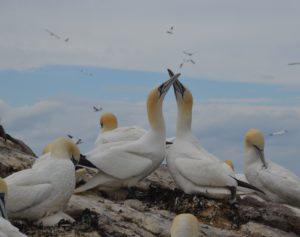
Gannets bonding.
Males offer bunches of seaweed to females to make a nest, in a repeated effort to find a mate. But much of the time the birds are fighting and snapping, protecting their nests from any interlopers.
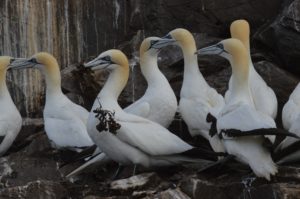
Males offer seaweed to potential mates.
Scientists from Leeds University are tagging the gannets for a study on the foraging behavior of the birds. All day they carefully catch, tag and release the birds. We speak little and stay close, careful of encroaching into gannet territory.
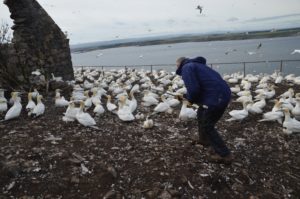
Catching gannets.
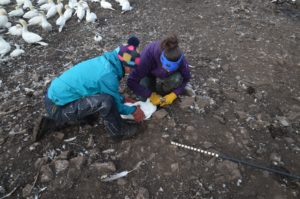
Putting gannets in a harness.
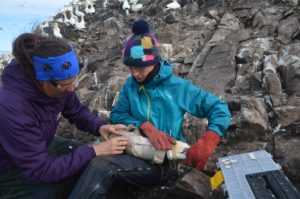
Tagging gannets.
Jude Lane, a PHD student, is tagging the birds with a GPS to find out where they fly. She is also fitting them with altimeters cellotaped to their tail feathers to measure the pressure and so the height the birds fly at. The resulting information will not only inform scientists about how the birds forage but could be important to the siting of offshore wind farms. Already Jude is building up a fascinating picture. The birds are specialists, either feeding on mackerel or herring, or following fishing boats and feeding on the discards. Each individual will have favoured feeding areas and species. DNA tests, necessary to show the sex of the bird, will help to see how males and females differ in behavior. Measuring the weight, wing span (Up to 2m) and beak will also give a picture of the growing population.
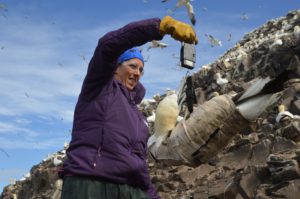
Weighing gannets.
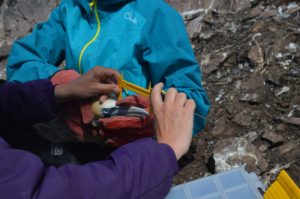
Measuring gannet beaks.
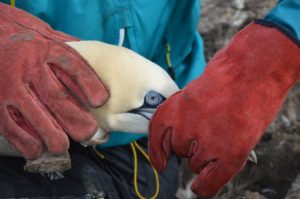
Careful to keep the beak shut.
The birds are captured gently using a noose or crook at the end of a long pole. The heavy birds are then bundled in a harness like swaddling a baby. I hold a bird while Jude carefully measures the wing span, attaches an altimeter and notes the tag. The sharp beak must be kept closed. (We all wear safety glasses at all times as the greatest danger is being pecked in the eye.) I hold the beak closed but allow the gannet to breathe. Since it has to dive into water, it has nostrils on the inside of its beak and cannot close its mouth for long without suffocating.
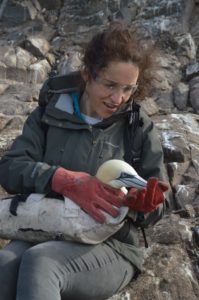
Me wearing safety glasses and gloves to keep gannet safe while scientists attach a tag.
Keith Hamer, Professor of Animal Ecology, who has been studying the birds for 13 years, has seen the population on the Bass Rock grow. When he came here in the 1970s it was possible to stay in the lighthouse overnight. Now the lighthouse has been automated and the living quarters have been closed. Only the engine room is used to store equipment.
Keith is pleased to see the the gannet population thriving, though he thinks the population cannot possibly get much bigger.
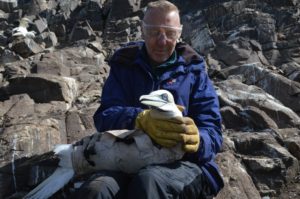
Prof Keith Hamer.
It very much feels like the gannets have taken over. My great great great grandfather Thomas Dale, who took on the tenancy of a local farm in 1837, had the right to take solan geese eggs and gugas. His ancestor, another Tom Dale, married the cousin of Robert Louis Stevenson and the lighthouse keeper in the book Catriona is called ‘Tam Dale’. Today there is still a Tommy Dale farming on the coast and it is his brother, my own cousin Robbie Dale who gives the scientists lifts out to the Bass Rock.
My own father remembers visiting the lighthouse in the 1970s and swapping eggs for vegetables. Now the small patch of green seen in old photos of the Bass has gone and it has become a rare wild place in the British Isles.
Shadows pass constantly over the ground, like those cast by a ceiling fan in a sunny room. The stink of guano seeps into our clothes and we have to raise our voices to be heard over the barking of the solan geese.
It is not until we are back on the main land that we step back into the human world. The only sound is the rush of the waves and, as we walk home past the ruins of a monastery, a song thrush singing in the woods.


